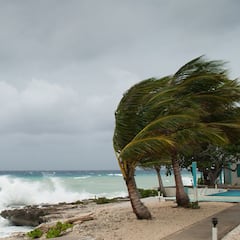Are more hurricanes coming to Florida after Helene? Updates on Isaac and Joyce
Hurricane Helene has caused devastation and over 40 lives in recent days, with experts monitoring what could come next.


Just when Floridians thought they might get a break after Hurricane Helene’s chaotic visit, the Atlantic has decided it’s not quite done with us. Forecasters are now keeping an eye on two new potential troublemakers: Hurricane Isaac and Tropical Storm Joyce. While both systems are still far from the mainland, we’ve learned from experience that you can never be too relaxed during hurricane season – especially when it comes to the unpredictability of Atlantic weather. Here’s what we know.
Isaac: growing stronger, but no immediate threat
Hurricane Isaac, currently a Category 1 storm, is flexing its muscles way out at sea with maximum sustained winds of 85 mph (140 kph). Right now, it’s about 995 miles west of the Azores, which means it’s closer to our friends in Portugal than those bracing themselves in Florida. For the moment, no coastal watches or warnings have been issued, but that doesn’t mean it’s time to switch off the weather channel.
Isaac is expected to strengthen further over the weekend before eventually weakening into a post-tropical cyclone by Monday. While it doesn’t look like it will be smashing into Florida, the storm is predicted to send some dangerous swells and rip currents towards the North Atlantic archipelago this weekend.
Hurricane #Isaac is going with the zonal flow of the Atlantic’s mid-latitude westerlies this morning, sustaining 90 mph winds and a 973 mbar pressure despite the tepid water temperatures available to him. Hovering near the threshold of Category 2 strength, Isaac is likely hitting… pic.twitter.com/tCrgnS4sVb
— Backpirch Weather (@BackpirchCrew) September 28, 2024
Joyce being closely monitored
On the other side of the Atlantic, Tropical Storm Joyce is also up to something. Though it’s not impacting any land (yet), the storm is forecast to intensify over the next few days. Joyce, currently 1,250 miles east of the northern Leeward Islands in the Caribbean, is packing maximum winds of around 50 mph. She’s inching northwest at a steady 13 mph, with a promise to gather a little more strength before calming down next week.
Just wanted to give a quick update on the busy tropics. #Issac and #Joyce aren't an issue for us but we will have to watch the Caribbean next week as low pressure may try to form and head northward into the Gulf. I'll keep you posted so keep checking back in. #weshwx pic.twitter.com/V8Y66eSAuO
— Tony Mainolfi (@TMainolfiWESH) September 28, 2024
What’s the aftermath of Hurricane Helene?
Before we get too focused on Isaac and Joyce, let’s not forget that Hurricane Helene has not yet passed. The Category 4 storm roared ashore earlier this week, leaving parts of the southeastern United States in bits, and taking more than 40 lives as it went. Helene wreaked havoc, toppling trees, flooding roads, and leaving many people without a home.
But with Isaac and Joyce stirring things up, the big question remains: are more hurricanes headed our way? While nothing is on the horizon for Florida at this moment, hurricane season is expected to be a risk until into November, and during this period things can change fast. Isaac and Joyce may stay far offshore, but it’s best to stay informed, check your local forecasts, and follow official guidance as its announced.
ON THIS DATE IN 1935: The Great Labor Day Hurricane of 1935 struck the Florida Keys. was the most intense Atlantic hurricane to make landfall on record in terms of pressure. The death toll was 408, including 250 World War I veterans in a rehabilitation camp. pic.twitter.com/1TxqI12ZlQ
— James Spann (@spann) September 2, 2020
What is the most powerful hurricane to hit the United States?
Since 1924, a century ago, the Atlantic has seen a total of 41 Category 5 hurricanes recorded, with the most recent one being Hurricane Beryl this past July. Category 5 is the highest level on the Saffir-Simpson scale, which rates hurricanes by their sustained wind speeds, which runs, as you may imagine, from Category 1, for the least severe, to Category 5, reserved for storms with winds of 157 miles per hour or more. There’s no upper limit! Once a hurricane hits that mark, it’s considered catastrophic.
Of those 41 Category 5 hurricanes, only four have made landfall with winds still above 157 miles per hour. Others came close but weakened just before hitting. Most of these superstorms happen in September, the busiest month of hurricane season in the Atlantic.
Related stories
The most powerful hurricane ever to hit the US was the Labor Day Hurricane of 1935. It slammed into the Florida Keys on September 2 with winds of 185 miles per hour, sometimes gusting over 200. The islands were swamped by a 15 to 20-foot storm surge, leaving widespread destruction in its wake.Lest we forget two other Category 5 hurricanes, namely Camille in 1969 and Michael in 2018, which struck the Gulf Coast with winds of 170 and 161 miles per hour, respectively. Hurricane Andrew in 1992 also left its mark, battering South Miami-Dade County with winds of 165 miles per hour.
While the states tends to focus on hurricanes in the Atlantic, tropical cyclones can form in oceans all over the world, in both hemispheres, as long as the conditions are right. Globally, the most powerful hurricane on record was Hurricane Patricia in 2015, which reached wind speeds of 215 miles per hour in the Eastern Pacific. By the time Patricia made landfall on Mexico’s western coast, it had weakened to a Category 4 with 150 mile-per-hour winds, but it still did serious damage.


Complete your personal details to comment